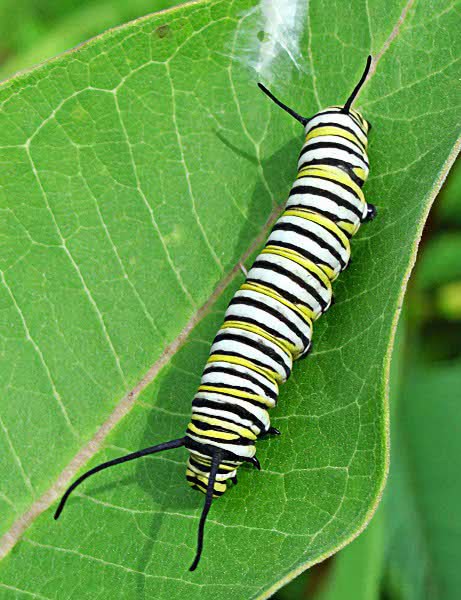 |
| Monarch on a Swamp Milkweed |
Monarch Butterflies are one of the most iconic insects in the United States. School children raise them in classrooms as they learn about the wonder of metamorphosis, and they are a welcomed sight into many gardens and parks. There are even festivals that celebrate them, and states, including Illinois, have adopted them as their state insect. However, they are most famous for making an epic migration that seems impossible for a butterfly to do. Monarchs east of the Rockies fly hundreds of miles on their journey south from Southern Canada to a small, remote area in Central Mexico. This begins in late summer and continues into the fall. This has been going on for millennia, but now these black-and-orange butterflies are facing challenges in the modern age that could end this great spectacle.
Illegal logging in the mountainous forests of Mexico has diminished their wintering grounds. Habitat loss and increased use of herbicides and pesticides in agricultural areas have decreased the number of milkweeds and other wildflowers, as well as their caterpillars. Food plants for these butterflies diminish more as roadsides are mowed and invasive weeds crowd out important native wildflowers. During the winter of 2013-2014, roughly 24% of the Monarch population returned to Mexico, which is one of the lowest numbers since records for this species have started. It all seems grim for the beloved Monarch Butterfly, but the individual homeowner can play a crucial role for the conservation of this species. But first, we must know about the life cycle of the Monarch, and what nectar sources they need to survive.
 |
| Butterflyweed Flowers |
Many butterflies are specialists, meaning that their caterpillars can only feed on one or several plant families to develop. Monarchs are a classic example of this. Their larvae can only eat milkweeds and nothing else. They absorb the toxins in the sap of milkweed to make them bad-tasting to birds and other animals. There are dozens of species of milkweeds (
Asclepias) in North America, and they are found in a variety of habitats from marshes and deserts, to woods and prairies. Many of these plants are viewed to be too aggressive for a garden setting, and are left for the wild. But milkweeds are declining in the wild, and they should be incorporated in the landscape. Luckily, there are a few Illinois native milkweeds that are garden-friendly and won't crowd out other plants. These are Swamp Milkweed (
Asclepias incarnata) and the appropriately named Butterflyweed (
Asclepias tuberosa). Swamp Milkweed is a tall, upright plant that reaches 3-4 feet tall and enjoys wet to moist soil, but can grow well in average garden conditions. It's bi-colored flower clusters are deep magenta with light pink centers, and release a pleasant, vanilla-like fragrance. It is a great plant for a wet spot in a sunny area. Butterflyweed is a short, shrubby milkweed that grows 2-3 feet tall and requires average to dry soils with good drainage. It has attractive, bright orange flowers that bloom throughout the summer. It is a great native plant for a dry sunny area. Both of these milkweeds not only fulfill the larval food source, but provide nectar for other butterflies and beneficial insects. Plant a few of these in you yard, and remember that they are the caterpillar food source, so you'll have to tolerate some defoliation. No worries, the plants will bounce back. Once the adults have formed, they need good nectar sources for food, and there are some great plants to use in your yard to provide nectar for monarchs, as well as other butterflies, beneficial insects, and hummingbirds. Here's a brief list of what to plant:
Natives:
- Giant Hyssop (
Agastache)
- Milkweeds (
Asclepias)
- Asters (
Aster)
-Tickseed (
Coreopsis)
- Purple Prairie Clover (
Dalea purpurea)
- Purple Coneflower (
Echinacea purpurea. Avoid double-flowered forms such as 'Raspberry Truffles' because they don't produce nectar.)
- Common Boneset (
Eupatorium perfoliatum)
- Spotted Joe Pye Weed (
Eupatorium maculatum)
- False Sunflower (
Heliopsis helianthoides)
- Blazing Star (
Liatris)
- Cardinal Flower (
Lobelia cardinalis)
- Wild Bergamot (
Monarda fistulosa)
- Garden Phlox (
Phlox)
- Obedient Plant (
Physostegia virginiana)
- Black-eyed Susan (
Rudbeckia)
- Culver's Root (
Veronicastrum virginicum)
 |
| Monarch Caterpillar |
Non-Natives:
- Tropical Milkweed (Asclepias curassavica)
- Butterfly Bush (
Buddleia)
- Blue Mist Shrub (
Caryopteris)
- Cosmos (
Cosmos)
- Shasta Daisy (
Leucanthemum 'Becky')
- Veronica (
Veronica 'Sonja')
By providing some of these plants (and most importantly, milkweed), you can create a habitat to benefit Monarchs on their long journey and to reproduce. Also, avoid using pesticides where those plants are present. You don't want to kill butterflies and other beneficial insects. A yard of any size can provide these plants for Monarchs, and help them survive in a changing landscape.


No comments:
Post a Comment